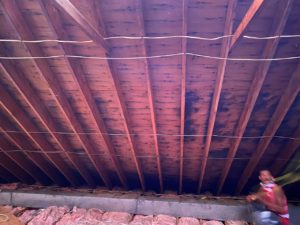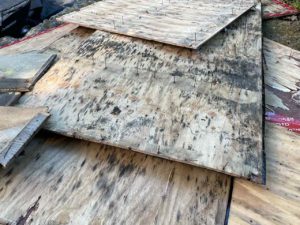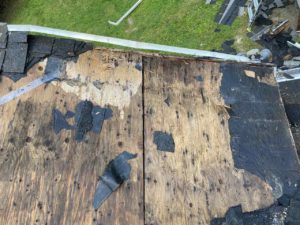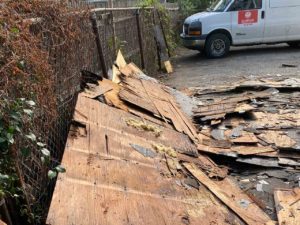If you’re like most people, you probably think of your attic as a place to store holiday decorations or extra furniture. What you may not know is that your attic plays an important role in the overall health and efficiency of your home.
Proper attic ventilation is important for a number of reasons. First and foremost, it helps to regulate the temperature in your attic, which can become extremely hot during the summer months. This can help to prevent damage to your roof and the structure of your home, as well as reduce the strain on your air conditioning system. Proper ventilation can also help to prevent moisture build-up in your attic, which can lead to the growth of mold and mildew, and can cause damage to your attic insulation.

Discolored or dark spots in wood are indicators of mold
Additionally, it can help to improve the air quality in your home by allowing excess moisture and pollutants to be removed from the air. Overall, proper attic ventilation is essential for maintaining the integrity and efficiency of your home.
What are the components that make up an attic ventilation system?
An attic ventilation system typically consists of two main components: intake vents and exhaust vents. The intake vents are located on the lower part of the roof, near the eaves, and are designed to allow fresh air to enter the attic. The exhaust vents, on the other hand, are located on the upper part of the roof, near the peak, and are designed to allow the hot, moist air that has collected in the attic to escape. Together, these two components work to create a balanced airflow in the attic, which helps to regulate the temperature and moisture levels.

Plywood roof decking removed due to mold
In some cases, an attic ventilation system may also include a mechanical or power vent, which is a fan that helps to move the air through the attic more effectively.
There are several types of passive vents that can be used for attic ventilation, including gable vents, roof vents, and soffit vents. Gable vents are vents that are installed in the gable walls of a house, which are the walls at the ends of the house that form a triangle with the peak of the roof. Roof vents are installed on the roof itself and are typically located near the peak of the roof. Soffit vents are installed in the soffit, which is the underside of the eaves of the roof.
Mechanical vents, also known as powered vents, are a type of vent that uses a fan or other mechanism to actively move air in and out of the attic space. Some examples of mechanical vents that are commonly used in attic ventilation include powered ridge vents, which are installed along the peak of the roof and use a fan to draw air out of the attic, and turbine vents, which use wind power to spin a turbine and draw air out of the attic. Other types of mechanical vents include solar-powered vents, which use energy from the sun to power a fan, and thermostatically controlled vents, which can be set to turn on and off based on the temperature in the attic. These types of vents can provide more effective ventilation than passive vents because they can move a larger volume of air and are not dependent on natural air flow.
How can I tell if I need additional attic ventilation?
There are a few signs that you may need additional attic ventilation. One of the most common signs is if you notice that your attic is extremely hot during the summer months. This can be a sign that the air in your attic is not circulating properly, and that you may need more intake or exhaust vents to improve the airflow. Another common sign is if you notice condensation or moisture on the underside of your roof, which can be a sign of excess moisture in your attic.

Mold damage on wood roof decking is the result of improper attic ventilation
Additionally, if you notice that your energy bills are higher than usual, or that your air conditioning system is struggling to keep your home cool, inadequate attic ventilation may be to blame. Finally, if you notice that your attic insulation is damp or has been damaged, this can also be a sign that you need more ventilation.

Roof deck removed due to mold damage
If you’re unsure whether you need additional attic ventilation, it’s a good idea to consult with a professional who can assess your attic and make recommendations.
How can I upgrade my attic ventilation?
If you believe that your attic ventilation is inadequate, there are a few steps you can take to upgrade it. The first step is to determine how much ventilation you currently have and what type of ventilation you have. This will typically involve going into your attic and looking for intake and exhaust vents. Once you have this information, you can consult with a professional to determine how much additional ventilation you need and what type of ventilation will work best for your home. In some cases, you may be able to add additional intake or exhaust vents to your existing system. In other cases, you may need to replace your existing vents with larger or more efficient ones. Once you have determined what you need, you can either install the new ventilation yourself or hire a professional to do it for you.